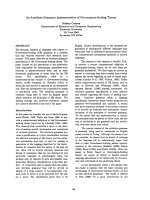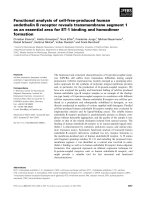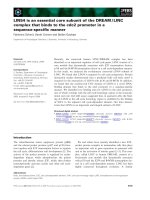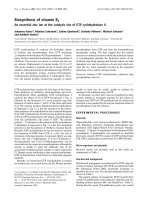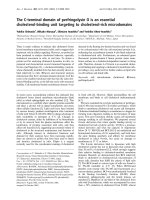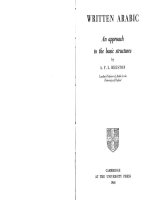arabic an essential grammar
Bạn đang xem bản rút gọn của tài liệu. Xem và tải ngay bản đầy đủ của tài liệu tại đây (1.69 MB, 366 trang )
Arabic
An Essential Grammar
‘The book has the great advantage of introducing Arabic grammatical
terminology in a manner that is clear and easy to follow . . . there is
nothing like it on the market at present and I believe it will be much
appreciated by teachers and students alike’
Stefan Sperl, Senior Lecturer in Arabic, SOAS, UK
Arabic: An Essential Grammar is an up-to-date and practical reference
guide to the most important aspects of the language. Suitable for
beginners, as well as intermediate students, this book offers a strong
foundation for learning the fundamental grammar structures of Arabic.
The complexities of the language are set out in short, readable sections
and exercises and examples are provided throughout.
The book is ideal for independent learners as well as for classroom
study.
Features of this book include:
• coverage of the Arabic script and alphabet
• a chapter on Arabic handwriting
• a guide to pronunciation
• examples provided throughout.
Faruk Abu-Chacra is Senior Lecturer Emeritus in Arabic at the Uni-
versity of Helsinki, Finland.
Routledge Essential Grammars
Essential Grammars are available for the following languages:
Chinese
Czech
Danish
Dutch
English
Finnish
German
Modern Greek
Modern Hebrew
Hungarian
Norwegian
Polish
Portuguese
Serbian
Spanish
Swedish
Thai
Urdu
Other titles of related interest published by Routledge:
Arabic–English Thematic Lexicon (forthcoming)
By Daniel Newman
Colloquial Arabic of Egypt
By Jane Wightwick and Mahmoud Gaafar
Colloquial Arabic of the Gulf and Saudi Arabia
(second edition forthcoming)
By Clive Holes
Modern Written Arabic: A Comprehensive Grammar
By El Said Badawi, Mike Carter and Adrian Gully
Arabic
An Essential Grammar
Faruk Abu-Chacra
First published 2007
by Routledge
2 Park Square, Milton Park, Abingdon, Oxon OX14 4RN
Simultaneously published in the USA and Canada
by Routledge
270 Madison Ave, New York, NY 10016
Routledge is an imprint of the Taylor & Francis Group, an informa business
© 2007 Faruk Abu-Chacra
All rights
reserved. No part of this book may be reprinted or
reproduced or utilized in any form or by any electronic,
mechanical, or other means, now known or hereafter
invented, including photocopying and recording, or in any
information storage or retrieval system, without permission in
writing from the publishers.
British Library Cataloguing in Publication Data
A catalogue record for this book is available from the British Library
Library of Congress Cataloging-in-Publication Data
Abu Shaqra, Faruq.
Arabic : an essential grammar / by Faruk Abu-Chacra.
p. cm.
1. Arabic language – Textbooks for foreign speakers – English.
I. Title.
PJ6307.A384 2007
492.7′82421—dc22
2006023828
ISBN10: 0–415–41572–1 (hbk)
ISBN10: 0–415–41571–3 (pbk)
ISBN10: 0–203–08881–6 (ebk)
ISBN13: 978–0–415–41572–9 (hbk)
ISBN13: 978–0–415–41571–2 (pbk)
ISBN13: 978–0–203–08881–4 (ebk)
This edition published in the Taylor &
Francis e-Library, 2007.
“To purchase your own copy of this or any of Taylor & Francis or Routledge’s
collection of thousands of eBooks please go to www.eBookstore.tandf.co.uk.”
ISBN 0-203-08881-6 Master e-book ISBN
v
Contents
Preface vii
Acknowledgements viii
List of abbreviations ix
1 Arabic script, transliteration and alphabet table 1
2 Pronunciation of consonants 5
3 Punctuation and handwriting 9
4 Vowels 13
5 Suku¯ n, sˇaddah, noun cases and nunation as indefinite form 17
6 Long vowels,
alif maqs
˙
u¯ rah, dagger or miniature
alif, word
stress and syllable structure 21
7 Hamzah (hamzatu l-qat
˙
i) and the maddah sign 26
8 Definite article
ـﻟْ أَ
al , nominal sentences, verbal
sentences, word order and adjectives 31
9 Sun and moon letters, hamzatu l-was
˙
li (was
˙
lah) 39
10 Gender 46
11 Conjunctions, prepositions and the particle
ﻰﺘ
ّ
َ
ﺣَ
h
˙
atta¯51
12
Id
˙
a¯ fah construction (genitive attribute) and the five nouns 61
13 Number: dual and plural 70
14 Perfect tense verbs, root and radicals, triliteral verbs and
word order 78
15 Separate personal pronouns and suffix pronouns 87
16 Demonstrative, reflexive and reciprocal pronouns 98
17 Imperfect tense verb in the indicative and word order 106
18 Derived verb forms (stems), roots and radicals, transitive
and intransitive verbs 115
19 Passive verbs 128
20 Rules for writing the hamzah (hamzatu l-qat
˙
i) 135
21 Broken plurals and collective nouns 144
22 Triptotes and diptotes 151
23 Participles, verbal nouns (mas
˙
dar), nouns of place, time and
instrument 160
24 Interrogative particles and pronouns, vocative particles 169
25 Adjectival patterns, relative adjectives (nisbah),
comparatives and superlatives, diminutives 181
26
Inna
ن
ّ
َ
إِ
and its sisters, ka¯ na
نَ ﺎـﻛَ
and its sisters 193
27 Relative pronouns and relative clauses 201
28 Moods: subjunctive, jussive (apocopatus) and imperative 209
29 Doubled verbs (mediae geminatae) and quadriliteral verbs 218
30 Verbs with hamzah 224
31 Verbs with a weak initial radical 231
32 Verbs with a weak middle radical 237
33 Verbs with a weak final radical, doubly weak verbs and
weak verbs with hamzah 246
34 Cardinal numbers 256
35 Ordinal numbers, fractions, expressions of time and
calendars 269
36 Exception 282
37 Verbs of wonder, the negative copula
ﺲَ ﻴْ ﻟَ
laysa, verbs with
special uses and some special uses of the preposition
ـﺑِ
bi 289
38 Adverbs and adverbials, absolute or inner object, h
˙
a¯ l
(circumstantial clause) and tamyı¯z (accusative of
specification) 299
39 Conditional sentences 309
Appendices
Appendix 1 Tables of verb forms 319
Appendix 2 Verb conjugation paradigms 328
Index 351
vi
Contents
vii
Preface
This book describes the fundamental grammar and structure of modern
literary Arabic. It is complete with exercises and offers a strong founda-
tion for reading and writing the Arabic of newspapers, books, broad-
casts and formal speech, as well as providing the student with a course
for self-study. The exercises and examples contain modern vocabulary
and expressions taken from everyday use.
The work contains thirty-nine chapters with an appendix of tables for
verb forms and verb conjugation paradigms. All chapters are progres-
sive and they complement each other. For this reason it is recommended
that the student master each lesson before going on to the next.
Up to chapter 22, a full transliteration into the Latin alphabet is given
for all Arabic examples and exercises. From chapter 22 onwards, the
transliteration is omitted from the exercises only.
There are two types of exercise: Arabic sentences translated into
English, and English sentences to be translated into Arabic. The words
of the English to Arabic translation exercises are taken from the Arabic
to English exercises of the same chapter.
So that readers do not have to use Arabic–English dictionaries, which a
learner of Arabic would find difficult at this stage, most Arabic words
in the exercises are indexed with a superscript number and the same
number is given to the equivalent English word.
I am confident that this book will prove to be of great help to those who
have begun or will begin the study of Arabic, and that teachers will find
it a useful aid.
viii
Acknowledgements
I would like to express my gratitude to my former colleagues at the
Institute for Asian and African Studies at the University of Helsinki
(Finland), especially Professor Tapani Harviainen and Dr Bertil
Tikkanen, and to Professor Daniel Newman of the University of
Durham (England) as well as Professor Benjamin Hoffez of Oakland
University (USA). They read the original manuscript and made
numerous valuable comments and suggestions for its improvement. In
addition I should also like to thank the anonymous reviewers appointed
by Routledge for their constructive criticism and advice.
I also acknowledge the generous financial support of the Ministry
of Education of Finland, the University of Helsinki, Alfred Kordelin
Foundation, Jenni and Antti Wihuri Foundation, and the Finnish
Association of Non-Fiction Writers.
Faruk Abu-Chacra
Helsinki, Finland, 2007
ix
Abbreviations
acc. accusative
act. active
C consonant
def. definite
dipt. diptote
du. dual
f./fem. feminine
gen. genitive
imperat. imperative
imperf. imperfect
indef. indefinite
indic./ind. indicative
intrans. intransitive
juss. jussive
lit. literally
m./masc. masculine
nom. nominative
part./particip. participle
pass. passive
pers. person
pl./plur. plural
prep. preposition
s./sing. singular
subj. subjunctive
trans. transitive
V. vowel
v. verb
1
Chapter 1
Arabic script, transliteration
and alphabet table
1.1 The Arabic script
The Arabic alphabet consists of 28 letters representing consonants. In
addition there are three vowel signs which are used in writing both short
and long vowels. Moreover, there are various other orthographic signs
that are explained in the following chapters.
The 28 letters are written from right to left. When writing words, the
letters are connected (joined) together from both sides, except in
the case of six letters, which can only be joined from the right side.
These letters are numbered 1, 8, 9, 10, 11 and 27 in the table below
and are marked with an asterisk (*). It is important to remember that
these letters cannot be connected to the following letter (i.e. on their left
side).
Most of the letters are written in slightly different forms depending on
their location in the word: initially, medially, finally or standing alone.
There are no capital letters.
Arabic grammarians use three different names for the alphabet:
ﺔُ ﻳ
ّ
َ
ﺪِ ﺠَ ﺑْ ﻷَ ْ فُ وﺮُ ﺤُ ـﻟْ أَ
al-h
˙
uru¯fu l-
abg˘adiyyatu
ﺔُ ﻴ
ّ
َ
ﺋِ ﺎﺠَ ﻬِ ﻟْ فُ وﺮُ ﺤُ ـﻟْ أَ
al-h
˙
uru¯fu l-hig˘a¯
iyyatu
ءُ ﺎﺒَ ـﻔْ ﻟِ ﻷَ ْ أَ
al-
alifba¯
u
1.2 Transliteration
The transliteration of the Arabic alphabet given below is based on the
Latin alphabet, but some of the letters have an extra sign indicating
some special feature of the Arabic pronunciation of the letter in
question.
The
alif (
ا
), which is the first letter, has so far not been given any
transliteration, because its sound value varies (to be dealt with in
chapters 6 and 7).
1.3 Alphabet table and transliteration
transliteration standing
alone
final medial initial name
(1) (*)
ا ﺎـ ﺎـ ا
Alif
(2) b
ب ﺐـ ـﺒـ ـﺑ
Ba¯
(3) t
ت ﺖـ ـﺘـ ـﺗ
Ta¯
(4) t
¯
ث ﺚـ ـﺜـ ـﺛ
T
¯
a¯
(5) g˘
ج ﺞـ ـﺠـ ـﺟ
G
˘
ı
-
m
(6) h
˙
ح ﺢـ ـﺤـ ـﺣ
H
˙
a¯
(7) h
˘
خ ﺦـ ـﺨـ ـﺧ
H
˘
a¯
(8) d (*)
د ﺪـ ﺪـ د
Da¯l
(9) d
¯
(*)
ذ ﺬـ ﺬـ ذ
D
¯
a¯l
(10) r (*)
ر ﺮـ ﺮـ ر
Ra¯
(11) z (*)
ز ﺰـ ﺰـ ز
Zayn
(12) s
س ﺲـ ـﺴـ ـﺳ
Sı
-
n
(13) sˇ
ش ﺶـ ـﺸـ ـﺷ
S
ˇ
ı
-
n
(14) s
˙
ص ﺺـ ـﺼـ ـﺻ
S
˙
a¯d
(15) d
˙
ض ﺾـ ـﻀـ ـﺿ
D
˙
a¯d
(16) t
˙
ط ﻂـ ـﻄـ ـﻃ
T
˙
a¯
(17) d
¯
˙
ظ ﻆـ ـﻈـ ـﻇ
D
¯
˙
a¯
2
Arabic
script,
transliter-
ation, the
alphabet
1.4 Writing letters in different positions
Below each letter is presented as it appears in different positions in
connected writing when using a computer or as written by hand.
(18)
ع ﻊـ ـﻌـ ـﻋ
Ayn
(19) g˙
غ ﻎـ ـﻐـ ـﻏ
G
˙
ayn
(20) f
فﻒـ
ـﻔـ
ـﻓ
Fa¯
(21) q
ق ﻖـ ـﻘـ ـﻗ
Qa¯f
(22) k
ك ﻚـ ـﻜـ ـﻛ
Ka¯f
(23) l
ل ﻞـ ـﻠـ ـﻟ
La¯m
(24) m
م ﻢـ ـﻤـ ـﻣ
Mı
-
m
(25) n
ن ﻦـ ـﻨـ ـﻧ
Nu¯n
(26) h
هﻪـ
ـﻬـ
ـﻫ
Ha¯
(27) w (*)
و ﻮـ ﻮـ و
Wa¯w
(28) y
ي ﻲـ ـﻴـ ـﻳ
Ya¯
(1)
ا ا ا ا
(2) b
ب ﺐـﺒـﺑ
(3) t
ت ﺖـﺘـﺗ
(4) t
¯
ث ﺚـﺜـﺛ
(5) g˘
ج ﺞـﺠـﺟ
(6) h
˙
ح ﺢﺤـﺣ
(7) h
˘
خ ﺦﺨـﺧ
(8) d
د د د د
(9) d
¯
ذ ذ ذ ذ
(10) r
ر ررر
3
Arabic
script,
transliter-
ation, the
alphabet
(11) z
ز ززز
(12) s
س ﺲـﺴـﺳ
(13) sˇ
ش ﺶـﺸـﺷ
(14) s
˙
ص ﺺﺼـﺻ
(15) d
˙
ض ﺾﻀـﺿ
(16) t
˙
ط ﻂﻄﻃ
(17) d
¯
˙
ظ ﻆﻈﻇ
(18)
ع ﻊـﻌـﻋ
(19) g˙
غ ﻎـﻐـﻏ
(20) f
ف ﻒـﻔـﻓ
(21) q
ق ﻖـﻘـﻗ
(22) k
ك ﻚـﻜـﻛ
(23) l
ل ﻞـﻠـﻟ
(24) m
م ﻢـﻤـﻣ
(25) n
ن ﻦـﻨـﻧ
(26) h
ه ﻪـﻬـﻫ
(27) w
و ووو
(28) y
ي ﻲـﻴـﻳ
4
Arabic
script,
transliter-
ation, the
alphabet
5
Chapter 2
Pronunciation of consonants
(1)
Alif
ا
This first letter has no pronunciation of its own. One of
its main functions is to act as a bearer for the sign hamzah,
discussed separately in chapter 7.
Alif is also used as a long vowel
/a¯ / (see chapter 6).
(2) Ba¯
ب
/b/ A voiced bilabial stop as the /b/ in English ‘habit’.
(3) Ta¯
ت
/t/ An unaspirated voiceless dental stop as the t in English
‘stop’. Never pronounced as American English tt as in ‘letter’.
(4) T
¯
a¯
ث
/t
¯
/ A voiceless interdental fricative as th in English ‘thick’,
‘tooth’.
(5) G
˘
ı¯m
ج
/g˘/ A voiced palato-alveolar affricate. In reality, this let-
ter has three different pronunciations depending on the dialectal
background of the speaker:
(a) In Classical Arabic and the Gulf area, as well as in many
other places in the Arab world, it is pronounced as a voiced
palato-alveolar affricate as the j in ‘judge’, ‘journey’, or the g
in Italian ‘giorno’.
(b) In Lower Egypt (Cairo, Alexandria) it is pronounced as a
voiced velar stop as the g in English ‘great’.
(c) In North Africa and the Levant it is pronounced as a voiced
palato-alveolar fricative /zˇ/ as the s in English ‘pleasure’, and
as j in French ‘jour’.
(6) H
˙
a¯
ح
/h
˙
/ This consonant has no equivalent in European
languages. It is pronounced in the pharynx by breathing with
strong friction and no uvular vibration or scrape, so that it sounds
like a loud whispering from the throat. It must be kept distinct
from the sounds of
خ
/h
˘
/ (7) and
ـﻫ
/h/ (26).
(7) H
˘
a¯
خ
/h
˘
/ This consonant occurs in many languages. It is a
voiceless postvelar (before or after /i/) or uvular (before or after /a/
or /u/) fricative, quite similar to the so-called ach-Laut in German
‘Nacht’ or Scottish ‘loch’ or the Spanish j in ‘mujer’, but in Arabic
it has a stronger, rasping sound.
(8) Da¯l
د
/d/ A voiced dental stop as the d in English ‘leader’.
(9) D
¯¯
a¯l
ذ
/d
¯
/ A voiced interdental fricative, as the th in English
‘either’.
(10) Ra¯
ر
/r/ A voiced alveolar trill, which differs from English r in
that it is a rolled sound or trill, pronounced as a rapid succession
of flaps of the tongue, similar to Scottish r in ‘radical’ or Italian r
in ‘parlare’ or Spanish rr in ‘perro’.
(11) Zayn
ز
/z/ A voiced alveolar sibilant, as the z in English ‘gazelle’.
(12) Sı¯n
س
/s/ A voiceless alveolar sibilant as the s in English ‘state’.
(13) S
ˇ
ı¯n
ش
/sˇ/ A voiceless palato-alveolar sibilant as the sh in
English ‘shave’, ‘push’.
(14) S
˙
a¯d
ص
/s
˙
/ Belongs to the group of emphatic consonants. The
emphatic consonants are pronounced with more emphasis and
further back in the mouth than their non-emphatic (plain)
counterparts. In pronouncing them the body and root of the
tongue are (simultaneously) drawn back towards the rear wall
of the throat (pharynx), and also the tip of the tongue is slightly
retracted. Hence the emphatic consonants are also called
pharyngealized consonants.
ص
/s
˙
/ is thus the emphatic or
pharyngealized counterpart of the plain alveolar
س
/s/ (12) and
sounds somewhat similar to the s in English ‘son’ or ‘assumption’.
For the retracting and lowering effect of the emphatic consonants
on the adjacent vowels, see chapter 4.
(15) D
˙
a¯d
ض
/d
˙
/ It is also an emphatic consonant, classified as a
pharyngealized voiced alveolar stop. Arab phoneticians and
reciters of the Quran recommend it is pronounced as a counter-
6
Pronuncia-
tion of
consonants
part to
د
/d/ (8). In current use in many dialects it is, however, also
pronounced as the counterpart of
ذ
/d
¯
/ (9), somewhat similar to
the sound th in English ‘thus’. See also chapter 4.
(16) T
˙
a¯
ط
/t
˙
/ An emphatic consonant, classified as a pharyngealized
voiceless alveolar stop. It is the counterpart of
ت
/t/ (3), and simi-
lar to the sound /t/ at the beginning of the English word ‘tall’. See
also chapter 4.
(17) D
˙
¯
a¯
ظ
/d
¯
˙
/ An emphatic consonant, classified as a pharyngealized
voiced interdental fricative. It is the emphatic counterpart of
ذ
/d
¯
/ (9). In some dialects it is pronounced as
ض
/d
˙
/ (15). In some
other dialects it is pronounced as pharyngealized
ز
/z/ (11). See
also chapter 4.
(18)
Ayn
ع
/
/ This consonant has no equivalent in European
languages. It is defined as a voiced emphatic (pharyngealized)
laryngeal fricative, which is pronounced by pressing the root of
the tongue against the back wall of the pharynx (upper part of the
throat) and letting the pressed air stream from the throat pass
through the pharynx with some vibration. In a way it is the voiced
counterpart of
ح
/h
˙
/ (6). It sounds as if you are swallowing your
tongue or being strangled.
(19) G
˙
ayn
غ
/g˙/ A voiced postvelar (before or after /i/) or uvular
(before or after /a/ or /u/) fricative, a gargling sound, produced
by pronouncing the
خ
/h
˘
/ (7) and activating the vocal folds,
similar to Parisian French r in ‘Paris’ and ‘rouge’ but with more
scraping.
(20) Fa¯
ف
/f/ A voiceless labiodental fricative as the f in English
‘fast’.
(21) Qa¯f
ق
/q/ This has no equivalent in European languages. It is a
voiceless postvelar or uvular stop, pronounced by closing the back
of the tongue against the uvula as if it were to be swallowed. It is
like
خ
/h
˘
/ (7) without vibration. This sound should not be con-
fused with
ك
/k/ (22), e.g.
ﺐﻠْ ﻗَ
qalb, ‘heart’, but
ﺐﻠْ ﻛَ
kalb ‘dog’.
(22) Ka¯f
ك
/k/ An unaspirated voiceless velar stop as the k of English
‘skate’.
7
Pronuncia-
tion of
consonants
(23) La¯m
ل
/l/ A voiced alveolar lateral as the l in English ‘let’.
(24) Mı¯m
م
/m/ A voiced bilabial nasal as the m in English ‘moon’.
(25) Nu¯ n
ن
/n/ A voiced alveolar nasal as the n in English ‘nine’.
(26) Ha¯
ـﻫ
(
ه
) /h/ A voiceless glottal fricative as the h in English
‘head’.
Note: This letter has another function when it occurs at the end of a word with
two superscript dots:
ة ، ﺔـ
Then it is pronounced exactly like
ت
/t/ (3) and is
called ta¯
marbu¯t
˙
ah (see chapter 10 on gender).
(27) Wa¯w
و
/w/ A voiced bilabial semivowel, as the w in English
‘well’.
(28) Ya¯
ي
/y/ A voiced alveo-palatal semivowel, as the y in English
‘yes’.
8
Pronuncia-
tion of
consonants
9
Chapter 3
Punctuation and handwriting
3.1 Punctuation
Punctuation marks are not found in early Arabic manuscripts. The
Arabs have borrowed modern European punctuation marks with some
modifications in order to distinguish them from Arabic letters, as
follows:
.
، : ؛ ! ؟
() ″〈〈〉〉
3.2 Arabic handwriting
It is recommended that handwriting technique is practised from the very
beginning, otherwise it may become difficult to learn not only to write
but even to read handwritten texts. Arabs consider good handwriting a
sign of erudition.
Printed and handwritten Arabic texts do not differ from each other as
much as they do in European languages.
Arabic handwriting follows certain rules. The straight horizontal direc-
tion used in writing English must be modified in Arabic handwriting,
since some of the letters change their form according to the preceding or
following letter.
3.3 Some remarks concerning the dots with certain consonants
The most common way of marking the dots which belong to certain
consonants in handwriting is to use a straight stroke instead of two
dots, as in /t/ or /y/; and instead of three dots, as in /t
¯
/.
One might suspect that the straight stroke replacing two dots could be
confused with the vowels fath
˙
ah
ـــَـــ
or kasrah
ـــِــ
, but this is not the
case, since these vowel signs are diagonal (slanting) strokes. As noted
above, handwritten as well as printed texts are normally written with-
out vowel signs.
Exercises
The examples below and in the next few chapters are intended mainly for
practising how to read and write Arabic script.
ﻖﺤﺳ ﻢﺠﻫ هﺮﻜﻧ حﺮﺟ
(1) s+h
˙
+qh+g˘+mn+k+r+hg˘+r+h
˙
ﻞﺣر ﻢﻬﻟ عرز قﺮﻏ
(2) r+h
˙
+ll+h+mz+r+
g˙+r+q
ﻢﺤﻟ ﻲﺴﻧ ﺐﻌﺗ ﺮﺤﺑ
(3) l+h
˙
+mn+s+yt+
+bb+h
˙
+r
ﻊﻤﺳ ﻞﻤﻋ ﻪﻨﻣ ﻎﺒﺻ
(4) s+m+
+m+lm+n+hs
˙
+b+g˙
كﺮﺗ عزو ﻢﺟﺮﺗ ﻞﻴﻣ
(5) t+r+kw+z+
t+r+g˘+mm+y+l
يﺰﻋ ﺶﺤﺟ ﺖﻜﺳ ﺢﺠﻧ
(6)
+z+yg˘+h
˙
+sˇ s+k+tn+g˘+h
˙
Punctuation
and
handwriting
10
ﻒﻜﻋ جﺮﺣد ﻲﻤﻋ ﻞﻴﻓ
(7)
+k+fd+h
˙
+r+g˘
+m+yf+y+l
سﺮﻏ ﻢﻬﻓ ﺮﺠﻫ بﺮﻫ
(8) g˙+r+sf+h+mh+g˘+rh+r+b
ﻖﻬﺑ ﻢﻋز ﻪﻤﻬﻓ سرد
(9) b+h+qz+
+mf+h+m+hd+r+s
ﺮﺒﺻ بﺮﺿ ﻊﺒﻃ ﻞﻄﺑ
(10) s
˙
+b+rd
˙
+r+bt
˙
+b+
b+t
˙
+l
دﺮﺳ ﻢﻠﻇ يﻮﻗ ضﺮﻣ
(11) s+r+dd
¯
˙
+l+mq+w+ym+r+d
˙
ﻊﺿو دﺮﺷ ﻪﻠﻬﻣ ﻂﺒﺿ
(12) w+d
˙
+
sˇ+r+dm+h+l+hd
˙
+b+t
˙
غﺮﻓ ﻢﻬﺷ ﺮﺴﻤﺳ كﺮﻋ
(13) f+r+g˙ sˇ+h+ms+m+s+r
+r+k
ﻢﺴﻗ كﺮﺑ ﻞﻜﺷ شﺮﻓ
(14) q+s+mb+r+ksˇ+k+lf+r+sˇ
Punctuation
and
handwriting
11
ﻢﺤﺷ رﻮﺼﻣ درﻮﻣ رﺪﺼﻣ
(15) sˇ+h
˙
+mm+s
˙
+w+rm+w+r+dm+s
˙
+d+r
ﺮﻬﺷ ﺚﻜﻣ ﻢﻄﻟ هﺪﻟو
(16) sˇ+h+rm+k+t
¯
l+t
˙
+mw+l+d+h
ﻢﺴﻗ كﺮﺑ فﺮﺷ قﻮﺷ
(17) q+s+mb+r+ksˇ+r+fsˇ+w+q
ﺢﺑذ ﻢﺣر قﺪﻨﻓ فﻮﺧ
(18) d
¯
+b+h
˙
r+h
˙
+mf+n+d+qh
˘
+w+f
ﺮﻜﺷ ﺐﺘﻜﻣ ﺪﻬﻧ ﺚﺤﺑ
(19) sˇ+k+rm+k+t+bn+h+db+h
˙
+t
¯
Punctuation
and
handwriting
12
13
Chapter 4
Vowels
4.1 There are three vowels in Arabic called
تُ ﺎﻛَ ﺮَ ﺤَ ـﻟْ أَ
al-
h
˙
araka¯ tu. They can be both short and long (see chapter 6).
4.2 Short vowels
The three short vowels are written as diacritical signs above or below
the consonant to which they belong. As a word always begins with a
consonant, the consonant is pronounced before the vowel.
Fath
˙
ah:
ــَــ
/a/ is a small diagonal stroke above the consonant:
بَ
/ba/, e.g.
ﺐَ ـﺘَ ـﻛَ
kataba, to write.
Kasrah:
ـــِـ
/i/ is a small diagonal stroke under the consonant:
بِ
/bi/, e.g.
ﻞَ ـﺒِ ـﻗَ
qabila, to accept.
D
˙
ammah:
ـــُـ
/u/ is a sign similar to a comma above the consonant:
بُ
/bu/, e.g.
ﻦَ ـﺴُ ـَ ﺣ
h
˙
asuna, to be handsome.
4.3 The sound quality of fath
˙
ah
ــَــ
/a/ tends to be slightly
coloured towards /æ/, like /a/ in the word ‘fat’ in English.
4.4 Short vowels are not normally marked in personal handwriting
or in most Arabic publications. In order to avoid misunderstandings, the
vowel signs are marked on unusual or foreign words, and in the Quran
and children’s books.
4.5 The vowel qualities of the three vowels mentioned above are
influenced by the emphatic (pharyngealized) consonants. The emphatic
consonants are most easily heard in conjuction with fath
˙
ah
ــَــ
/a/,
which is then coloured towards /o/, or to American English /u/ in ‘but’
or /o/ in ‘bottle’, ‘hot’, etc.
Example: The non-emphatic /s/ in the word
ﺐَ ﻠَ ـﺳَ
salaba ‘to steal’
sounds like sælæbæ, but the emphatic /s
˙
/ in the word
ﺐَ ﻠَ ﺻَ
s
˙
alaba ‘to
crucify’ sounds almost like s
˙
olobo.
Note a: The following two consonants may sometimes also function as
emphatic:
ر
/r/ (10), and
ل
/l/ (23) only with the word
ﻪُ ﻠّ
ا
ﻟأَ
alla¯ h, ‘God’.
Note b: The uvular
ق
/q/ has almost the same effect on the adjacent vowels as
the emphatic consonants. Thus the word
ﺐﻠْﻛَ
kalb, ‘dog’, with a velar /k/,
sounds almost like kælb, whereas
ﺐﻠْﻗَ
qalb ‘heart’, with an uvular
ق
/q/,
sounds almost like qolb.
Note c: Phonologically the above sounds /æ/ and /o/ both represent the fath
˙
ah
ـــَـ
. However, in the transliteration system used in this book they are replaced
by /a/. This is because they function as /a/ phonemically.
Exercises
Read and practise your handwriting:
Emphatic consonants Corresponding non-emphatic
consonants
صَ
(14) towards /s
˙
o/ counterpart of
سَ
(12) towards /sæ/ as in ‘sat’
ضَ
(15) towards /d
˙
o/ counterpart of
دَ
(8) towards /dæ/ as in ‘dam’
طَ
(16) towards /t
˙
o/ counterpart of
تَ
(3) towards /tæ/ in ‘tat’
ظَ
(17) towards /d
¯
˙
o/ counterpart of
ذَ
(9) towards /d
¯
æ/ in ‘that’
ﺰَ ـﺒَ ـﺧَ هَ ﺮِ ﻛَ ﻊَ ﻤِ ـﺳَ ﺪَ ﻬِ ﺷَ غَ ﺮِ ﻓَ
(1) h
˘
abaza kariha sami
asˇahida farig˙a
to bake to dislike to hear to witness to be empty
سَ رَ دَ بَ ﺮُ ـﻗَ مَ ﺮُ ـﻛَ ﻞَ ـﻘُ ـﺛَ ﻪُ ﻌَ ﻤِ ﺳَ
(2) darasa qaruba karuma t
¯
aqula sami
ahu
to study to be near to be noble to be heavy he heard him
Vowels
14



